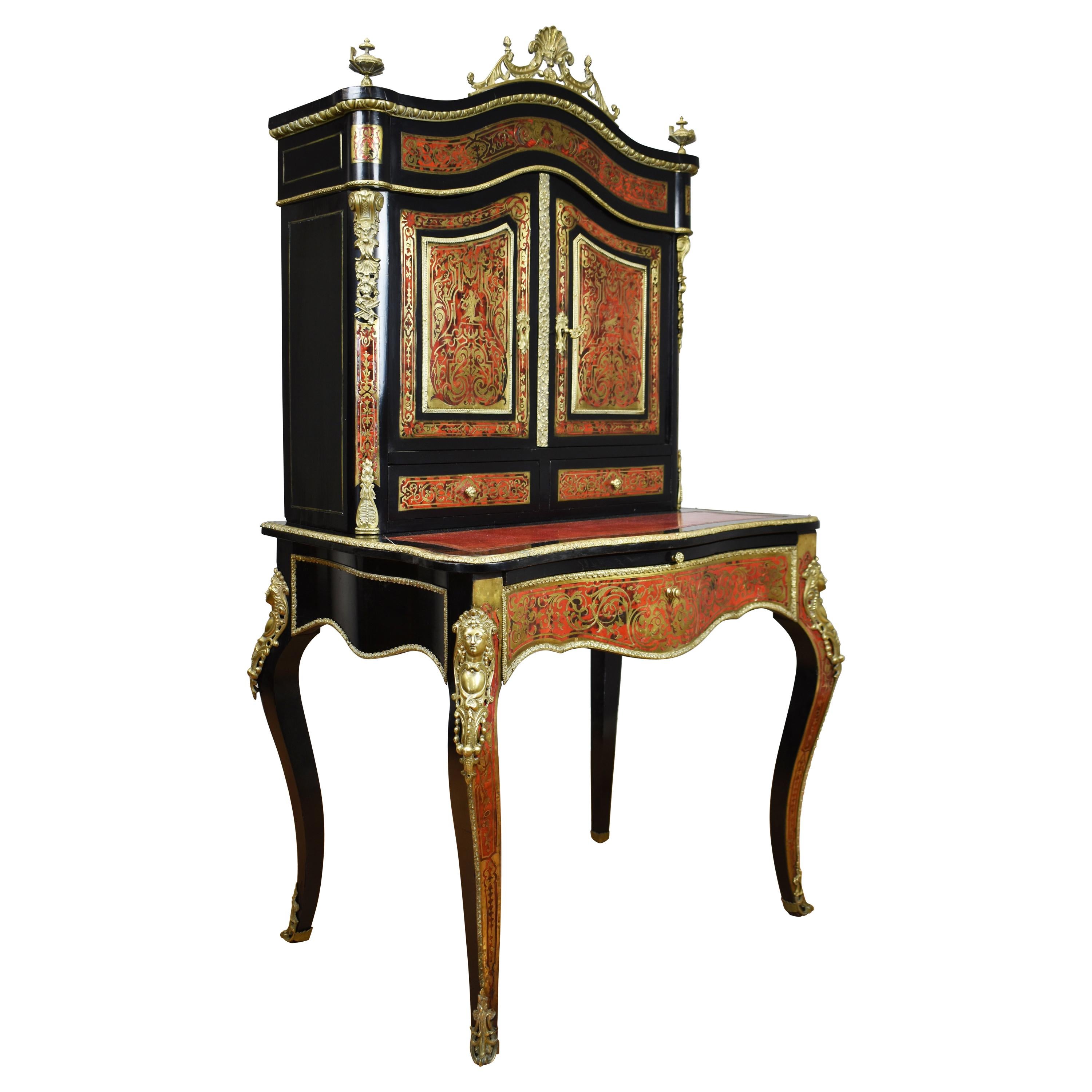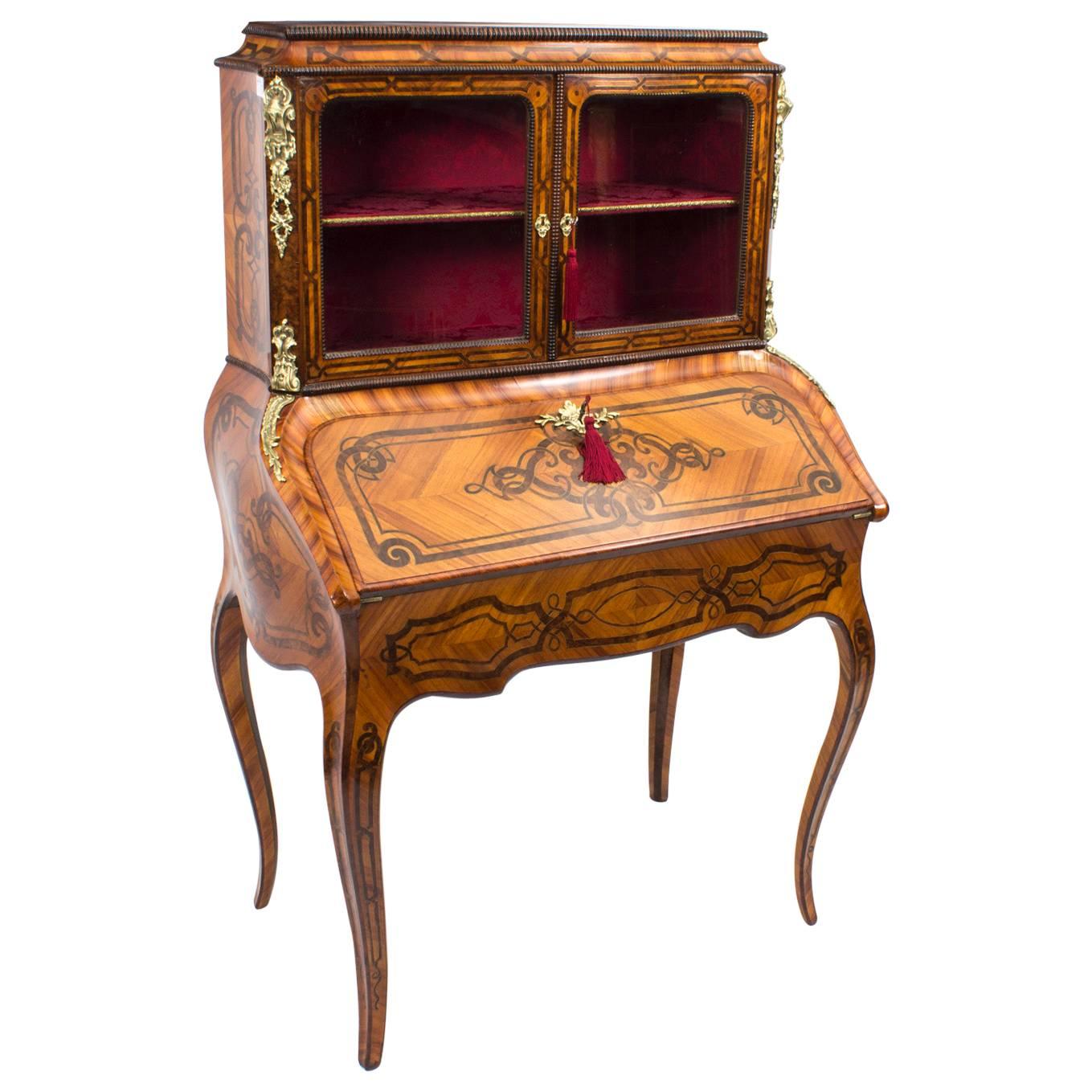Items Similar to 19th Century, Louis XV Revival Ormolu-Mounted Bonheur Du Jour by Diehl
Want more images or videos?
Request additional images or videos from the seller
1 of 10
19th Century, Louis XV Revival Ormolu-Mounted Bonheur Du Jour by Diehl
About the Item
Highly important and palatial Napoleon III Louis XV Revival Ormolu-Mounted Marquetry Bonheur Du Jour by Charles Guillaume Diehl, Designed by Jean Brandely, The Marquetry by E. Varlot, Paris. The rarity & importance of this magnificent piece cannot be overstated, it is without question one of the finest examples you will see. Originally commissioned for European nobility as a statement of love and marital grandeur. Incorporating the finest & rarest veneers and timbers of the time, including Harewood, Thuya, Purpleheart, palm wood and tulipwood.
The beautifully shaped ormolu gallery on the top, gracefully curving outwards inset with fretted heart shapes highlight the incredible attention to detail that flow throughout this majestic piece. The upper section set either side with ormolu mounted fluted pilasters, aside two doors both individually set with masculine & feminine central marquetry panels of the most supreme quality, as you would expect from the master E. Varlot. The colors incorporated in the inlay are outstanding to behold, simply perfection. Opening to reveal the double top & bottom lock, engraved with Diehl's mark and address. Internally veneered in Rosewood of the richest color with one shelf. With two drawers below the doors, both veneered on the inside with Sycamore, one fitted for inkwells. The ormolu edged writing flap again centrally set with both a male & female figure now seated, holding hands with the lady holding a Mandoline, a true sign of happiness & love. The writing flap opening to reveal the original richly tooled velvet leather surface. The stand with one central frieze drawer, again lined inside with rosewood and with a top and bottom lock. On ormolu-mounted fluted legs.
This grand Museum Quality masterpiece is in excellent condition for its age.
Charles Guillaume Diehl (1811-1885) was of Germanic origins, he is considered among the most important & influential of cabinetmakers of the 19th century. He was born in Steinbach, Germany later moving to France, establishing his atelier in Paris in 1840, at the 3, Rue de Thorigny and then at the 170, Rue Saint-Martin, but he was only listed in the Commerce Almanach starting from 1850. At this date, his business settled at the 16, rue Michel-le-Comte. Due to his success he expanded his business to number 21 of this same street and at finally at number 19 from 1853 until his death in 1885. His workshops were situated at the 39, rue Saint-Sébastien, where by 1870 due to his incredible success he employed six hundred workers. Diehl participated in the Great Exhibition in 1851 and in all the major international exhibitions during the middle of the 19th Century thereafter. At the 1867 Universal Exposition, Diehl was awarded a silver medal, and the winning cabinet he presented that year is one of the pieces of furniture most often cited and reproduced of the period. He exhibited it in 1873 at the Universal Exposition of Vienna and obtained a medal of progress. Diehl became a naturalized French citizen in 1872. Parisians and international clientele alike desired the superbly designed and crafted luxury objects he produced. Diehl added to his incomparable savoir-faire a science of decorum, without hesitating to use the priciest elements of the time: rare woods, finely chiselled bronzes or the finest tapestries. He also added a unique cultural dimension by taking the time to pursue elaborate historical research to perfect his work. And thanks to the different Universal Exhibitions to which he participated, he entered into the history of the French Decorative Arts. One must also remember about Diehl that his chief ébéniste, Kowalewski, was without question the best cabinetmaker of his era. His most important pieces were designed by Jean Brandely. Described as "a bold, strange artist, an enterprising man with spontaneity" ( Auguste Luchet in L'Art Industrielle à l'Exposition Universelle de 1867: Mobilier, vêtements, aliments, Paris, 1868 ), Brandely provided plans for furniture and designs for both marquetry and bronze applications. As with this masterpiece, it would undoubtedly been conceived my Jean Brandely with the marquetry designed by the renowned E. Varlot. Diehl’s furniture pieces are regularly stamped & or engraved but not often dated. His pieces reside in European Palaces & in such prestigious Museums as the Musée d’Orsay, Paris - Musée des Arts Décoratifs, Paris - Metropolitan Museum of Art, New York - Musée de l’Ermitage, Saint Petersburg - Rijksmuseum, Amsterdam - Philadelphia Museum of Art, Philadelphia & Château de Compiègne, France.
Critically acclaimed as one of the most innovative artists of the 19th century, Diehl enlisted the partnership of his designers to challenge the rigid hierarchy that relegated the decorative arts, beneath that of the major arts of architecture, painting and sculpture. The result was a series of furniture and small items of remarkable sophistication, created with a wealth of detail and of exceptional quality, of which this Bonheur Du Jour is a fine and rare example. His output was described during the 1878 Exposition Universelle as some of the most important of its time.
Approximate Size:
Height: 54.5 inches
Width: 32.65 inches
Depth: 18.75 inches
A truly magnificent, palatial & important masterpiece.
- Creator:Charles-Guillaume Diehl (Cabinetmaker)
- Dimensions:Height: 54.5 in (138.43 cm)Width: 32.65 in (82.94 cm)Depth: 18.75 in (47.63 cm)
- Style:Louis XV (In the Style Of)
- Materials and Techniques:
- Place of Origin:
- Period:
- Date of Manufacture:circa 1865
- Condition:Wear consistent with age and use.
- Seller Location:London, GB
- Reference Number:1stDibs: LU120426891353
About the Seller
4.9
Gold Seller
These expertly vetted sellers are highly rated and consistently exceed customer expectations.
Established in 2012
1stDibs seller since 2015
115 sales on 1stDibs
Typical response time: 1 hour
- ShippingRetrieving quote...Ships From: London, United Kingdom
- Return PolicyA return for this item may be initiated within 7 days of delivery.
More From This SellerView All
- A Fine 19th Century Mahogany Pedestal DeskLocated in London, by appointment onlyA very fine and good looking pedestal desk, the leather top with brass bound edges, above a bank of four drawers on each side with one central drawer, the back with dummy drawers. Th...Category
Antique Late 19th Century English Early Victorian Desks and Writing Tables
- Late 19th Century Calamander Wood Glazed CabinetLocated in London, by appointment onlyA fine late 19th century calamander wood vitrine cabinet, the top, and front veneered in calamander wood and the sides ebonised, the front and corners ...Category
Antique 19th Century English Victorian Cabinets
MaterialsBronze
- Late 19th Century Napoleon III Marquetry Side CabinetLocated in London, by appointment onlyA fine 19th century Napoleon III side cabinet with inlaid marquetry panels, book matched sides with gilt bronze mounts of classical figures and foliage. The top drawer and central pa...Category
Antique 1870s French Cabinets
- Late 19th Century Napoleon III French Vitrine CabinetLocated in London, by appointment onlyA fine late 19th century Napoleon III glazed cabinet on chest, the shaped grey marble top above a curved frieze and mounted with fine gilt bronze mounts. The vitrine with a full widt...Category
Antique 19th Century French Neoclassical Cabinets
MaterialsMarble, Bronze
- Fine Regence, Louis XV, Baroque or Rococo Marquetry Cabinet BuffetLocated in London, by appointment onlyA wonderfully rich and decorative early 18th century marquetry buffet cabinet of generous proportions, veneered in highly figured timbers and retaining its original scalloped marble-...Category
Antique Early 18th Century French Cabinets
MaterialsFruitwood
- Dresden Porcelain Mounted Ebonised Bureau CabinetLocated in London, by appointment onlyA rare 19th century ebonised bureau cabinet in the high Napoleon III style, the desk is ebonised and mounted with numerous plaques of fine porcelain de...Category
Antique Late 19th Century Desks and Writing Tables
MaterialsPorcelain
You May Also Like
- 19th Century French Bonheur Du JourLocated in Chelmsford, EssexFor sale is a fine quality 19th century ebony and Thuya wood Bonheur Du Jour. The bonheur du jour has a brass gallery around the top, above a central mirror...Category
Antique Mid-19th Century French Desks
MaterialsEbony, Amboyna
- 19th Century French Bonheur Du Jour Writing DeskLocated in Vancouver, British ColumbiaA pretty French Louis XV style writing desk or ‘bonheur du jour’, the serpentine case veneered in book-matched Kingwood and raised on elegant cabriole legs and accented with gilt tri...Category
Antique Late 19th Century French Louis XV Desks and Writing Tables
MaterialsKingwood
- 19th Century Ebonised Boulle Bonheur Du JourLocated in Chelmsford, EssexFor sale is a fine quality 19th century ebonised Boulle Bonheur Du Jour writing table. The top, of arched form, has an ornate brass pediment, flanked by...Category
Antique Mid-19th Century French Victorian Desks
- 19th Century Walnut Inlaid Bonheur du JourLocated in Cheshire, GB19th-century walnut writing table of serpentine form, the raised superstructure top with fitted shelves and brass gallery, flanked by two banks of drawers. To the well figured serpen...Category
Antique Late 19th Century British Desks and Writing Tables
MaterialsWalnut
- Antique French Marquetry Bonheur du Jour 19th CenturyLocated in London, GBWe are very pleased to be able to offer this rare antique French walnut and marquetry inlaid Bonheur du Jour, or Ladies Writing Desk, for sale. Our experts have dated it to around 1...Category
Antique 1850s French Desks and Writing Tables
MaterialsWalnut
- 19th Century Victorian Amboyna Inlaid Bonheur Du JourLocated in London, GBBelieved by our experts to date from around 1860, this antique Victorian Bonheur Du Jour is an imposing and functional item of furniture that is so typical of the Victorian era. We ...Category
Antique 1860s English Victorian Desks and Writing Tables
MaterialsBrass, Ormolu
Recently Viewed
View AllMore Ways To Browse
Table 16seat
16 Seat Table
16 Seater Table
Charles Iii Furniture
Antique Desk With Shelf
Small Louis Xv Table
Louis Xv Important
Two Seat Desk
Two Seater Desk
Antique Desk Drawer Lock
Table Amp
Office Desk 21 Century
Small Shelf Desk
Desk In Rosewood And Leather
Small European Desk
Ormolu European Bronzes
French Louis Small Desk
Antique Leather Inlay Writing Desk





